
Eucryphia is a small genus of trees and large shrubs native to the south temperate regions of South America and coastal eastern Australia, mainly Tasmania. Sometimes placed in a family of their own, the Eucryphiaceae, more recent classifications place them in the Cunoniaceae. There are seven species, two in South America and five in Australia, and several named hybrids.
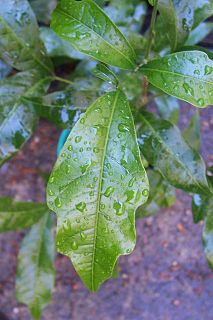
Diploglottis campbellii is a rainforest tree northern New South Wales and southeastern Queensland. Growing to 30 metres tall, it is commonly known as the small-leaved tamarind. It is rare and threatened and is restricted to a small number of sites, each with a maximum of 3 trees per site. However, it is readily available from nurseries in the Northern Rivers area of New South Wales, and in south-eastern Queensland.
Eucryphia jinksii, the Springbrook leatherwood, is a species of rare rainforest trees found in Queensland and New South Wales, Australia, of the plant family Cunoniaceae.

Acradenia euodiiformis, commonly known as yellow satinheart or bonewood, is a species of tree that is endemic to eastern Australia. It has mostly trifoliate leaves, the leaflets narrow elliptic to lance-shaped, with prominent oil glands, and panicles of white flowers. It grows in and near rainforest.
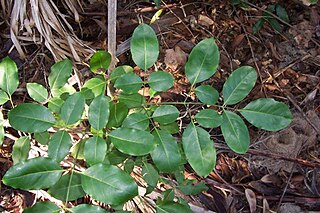
Polyscias elegans, known as the celery wood, is a rainforest tree of eastern Australia. It occurs in a variety of different rainforest types, from fertile basaltic soils, to sand dunes and less fertile sedimentary soils. The range of natural distribution is from Jervis Bay in southern New South Wales to Thursday Island, north of the Australian continent. Other common names include black pencil cedar and silver basswood. Polyscias elegans is useful to bush regenerators as a nursery tree, which provides shade for longer-lived young trees underneath. Polyscias elegans is also known as Celery wood, Mowbulan whitewood, Silver basswood and White sycamore.

Rhodosphaera is a genus of plants in the family Anacardiaceae. The genus includes a single species, Rhodosphaera rhodanthema, which is a rainforest tree of eastern Australia. It grows in sub tropical rainforests and also in the drier form of rainforests. The natural range of distribution is from the Macleay River, New South Wales to Maryborough in south east Queensland. Common names include deep yellowwood, yellow cedar and tulip satinwood.

The Monga National Park is a 251.44-square-kilometre (97.08 sq mi) national park located 230 kilometres (140 mi) south west of Sydney, New South Wales, Australia. The closest town nearby is Braidwood.

Telopea mongaensis, commonly known as the Monga waratah or Braidwood waratah, is a shrub or small tree in the family Proteaceae. Endemic to Australia, it grows at high altitude in south eastern New South Wales, where it is often seen in moist areas at the edge of rainforest or by streams in eucalyptus forests. Growing to 6 m (20 ft) high, it has narrow green leaves 4–18 cm (1.6–7.1 in) in length, and 0.5–2 cm (0.20–0.79 in) wide. In spring bears many red flowerheads, each made up of 28 to 65 individual flowers.

Symplocos thwaitesii, or the buff hazelwood, is a rainforest tree growing in eastern Australia. Seen in tropical, sub-tropical and warm temperate rainforests, often in gullies. Occasionally it grows in cooler situations such as at Monga National Park.

Polyscias sambucifolia, commonly known as elderberry panax or small basswood, is a species of plant native to eastern Australia.
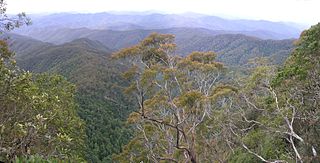
The Eastern Australian temperate forests or temperate eucalypt forests are an ecoregion of open forest on uplands starting from the east coast of New South Wales in the South Coast to southern Queensland, Australia. Four distinguishable communities are found within this ecoregion: subtropical rainforest, subtropical dry rainforest, warm temperate rainforest, and cool temperate rainforest, where they may also grade to other biomes, depending on the location.

Elattostachys nervosa, known as the green tamarind or beetroot tree is a common rainforest tree of eastern Australia. Found in all types of rainforest, growing from Paterson, New South Wales in the south to Gympie in south east Queensland. The name Elattostachys refers to "little spikes", a flower feature of other plants in this genus. Nervosa refers to the prominent leaf venation. Beetroot Tree refers to the beetroot red leaves of the new growth.
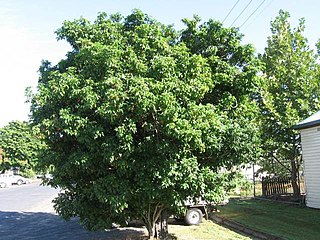
Harpullia pendula, known as the tulipwood or tulip lancewood is a small to medium-sized rainforest tree from Australia. The tree's small size, pleasant form and attractive fruit ensures the popularity of this ornamental tree. The range of natural distribution is from the Bellinger River in northern New South Wales to Coen in tropical Queensland. Tulipwood occurs in various types of rainforest, by streams or dry rainforests on basaltic or alluvial soils. In tropical and sub tropical rainforest. Often seen as a street tree, such as at St Ives, New South Wales.

Vesselowskya venusta is a rainforest plant of restricted distribution from eastern New South Wales, Australia. The common name is Barrington Tops marara. The species name venusta is from the Latin, meaning "charming". Referring to the beauty of the long flower stems. The genus is named after the Russian botanist E. Vesselowsky.
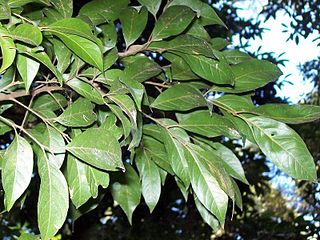
Sarcopteryx stipata, known as the steelwood, is a rainforest tree of eastern Australia occurring from the Bulga Plateau and Comboyne Plateau north west of Taree, New South Wales as far north as Fraser Island off the coast of south eastern Queensland. It grows in sub tropical rainforest but sometimes occurs in warm temperate rainforests on poorer soils. It is a member of the soap berry family. The generic name Sarcopteryx translates to "fleshy wing", as the fruit can be wing shaped. Stipata means "surrounded". The common name steelwood refers to the very tough, hard and heavy timber.

Cupaniopsis baileyana is a species of flowering tree in the soapberry family. It is native to eastern Australia. Common names include White Tamarind and Toothed Tuckeroo. The species name honours the botanist F.M.Bailey.

Randia moorei, commonly known as the spiny gardenia, is a rare Australian shrub growing in the far north eastern areas of the state of New South Wales and adjacent areas in Queensland. The habitat is subtropical rainforest north of Lismore.

Ochrosia moorei, known as the southern ochrosia is a rainforest plant of eastern Australia. Endangered by extinction, it has a ROTAP rating of 2ECi.
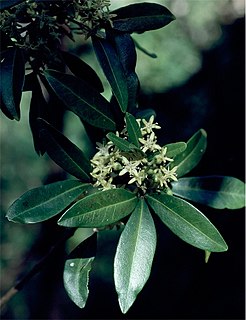
Acronychia suberosa , commonly known as corky acronychia, is a species of small to medium-sized rainforest tree that is endemic to eastern Australia. It has mostly trifoliate leaves with ellitic to egg-shaped leaflets with the narrower end towards the base, small groups of cream-coloured flowers and elliptical to spherical, creamy yellow to whitish fruit.
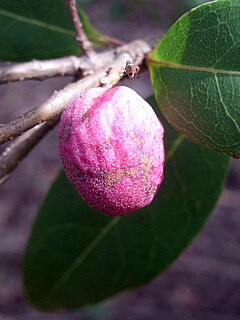
Notelaea ligustrina, known as the privet mock olive, native olive, doral or silkwood, is a plant in the olive family, found in south eastern Australia. Growing in and near rainforests south of Monga National Park in New South Wales, and into Victoria and the island state of Tasmania. The specific epithet ligustrina refers to the Privet, which it resembles.






















